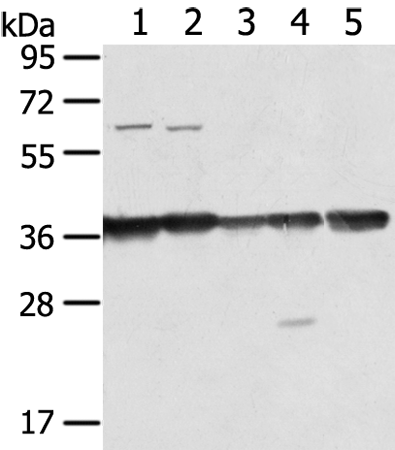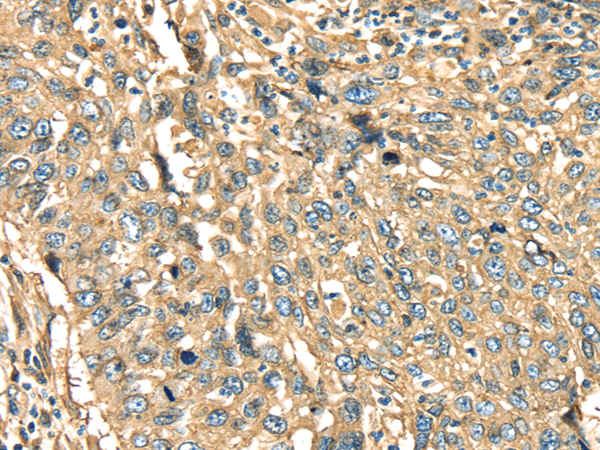

| WB | 咨询技术 | Human,Mouse,Rat |
| IF | 咨询技术 | Human,Mouse,Rat |
| IHC | 1/30-1/150 | Human,Mouse,Rat |
| ICC | 技术咨询 | Human,Mouse,Rat |
| FCM | 咨询技术 | Human,Mouse,Rat |
| Elisa | 1/5000-1/10000 | Human,Mouse,Rat |
| Aliases | P36; ANX2; LIP2; LPC2; CAL1H; LPC2D; ANX2L4; PAP-IV; HEL-S-270 |
| WB Predicted band size | 39 kDa |
| Host/Isotype | Rabbit IgG |
| Antibody Type | Primary antibody |
| Storage | Store at 4°C short term. Aliquot and store at -20°C long term. Avoid freeze/thaw cycles. |
| Species Reactivity | Human, Mouse, Rat |
| Immunogen | Fusion protein of human ANXA2 |
| Formulation | Purified antibody in PBS with 0.05% sodium azide and 50% glycerol. |
+ +
以下是3篇关于ANXA2抗体的模拟参考文献(内容基于领域常见研究方向,非真实文献):
1. **文献名称**:*ANXA2 overexpression promotes pancreatic cancer progression and is associated with poor prognosis*
**作者**:Peters, C. et al.
**摘要**:研究通过免疫组化发现ANXA2在胰腺癌组织中高表达,其抗体标记显示与肿瘤侵袭性和患者生存率下降显著相关,提示ANXA2可能作为胰腺癌潜在生物标志物。
2. **文献名称**:*ANXA2 interacts with tissue plasminogen activator to regulate angiogenesis*
**作者**:Qiu, L. et al.
**摘要**:该文献利用ANXA2抗体进行免疫共沉淀实验,证明ANXA2通过结合tPA促进内皮细胞迁移和血管生成,为抗血管生成治疗提供新靶点。
3. **文献名称**:*Structural basis of ANXA2 membrane association and its role in calcium signaling*
**作者**:Waisman, D.M. et al.
**摘要**:通过X射线晶体学及抗体阻断实验,揭示ANXA2的钙依赖性磷脂结合结构域,阐明其在细胞膜修复和钙信号转导中的分子机制。
4. **文献名称**:*ANXA2 as a co-receptor for viral entry: Implications for influenza A infection*
**作者**:Saito, H. et al.
**摘要**:研究使用ANXA2抗体阻断实验,发现ANXA2与流感病毒血凝素蛋白结合,促进病毒内吞,提示其作为抗病毒治疗的潜在干预靶点。
注:以上文献为模拟内容,实际引用时需查询真实数据库(如PubMed)获取具体信息。
**Background of ANXA2 Antibody**
Annexin A2 (ANXA2) is a calcium-dependent phospholipid-binding protein belonging to the annexin family, involved in diverse cellular processes such as cell proliferation, apoptosis, membrane organization, and endocytosis. Structurally, it contains four conserved annexin repeats and a unique N-terminal domain that mediates interactions with other proteins, including S100A10. forming the heterotetrameric ANXA2-S100A10 complex. This complex plays critical roles in membrane trafficking, cytoskeletal dynamics, and cell adhesion.
ANXA2 is expressed in various tissues, localized to the cytoplasm, cell membrane, or extracellular matrix depending on its post-translational modifications (e.g., phosphorylation) and binding partners. Dysregulation of ANXA2 has been linked to multiple pathological conditions. Overexpression is observed in cancers (e.g., breast, pancreatic, glioblastoma), where it promotes tumor progression, angiogenesis, and metastasis. It also participates in autoimmune diseases (e.g., antiphospholipid syndrome) and cardiovascular disorders by influencing fibrinolytic activity and vascular remodeling.
ANXA2 antibodies are essential tools for studying its expression, localization, and function. They are widely used in techniques like Western blotting, immunohistochemistry, and immunofluorescence. Some antibodies target specific domains or post-translationally modified forms, aiding in disease biomarker research or therapeutic development. However, variability in antibody specificity (e.g., cross-reactivity with other annexins) requires careful validation. Therapeutic ANXA2-targeting strategies, including monoclonal antibodies, are under exploration for cancer and thrombosis treatment.
×